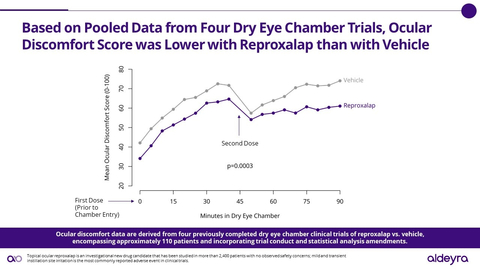Aldeyra Therapeutics Completes Enrollment in Phase 3 Clinical Trial of Reproxalap in Dry Eye Disease
Aldeyra Therapeutics (Nasdaq: ALDX) has completed enrollment for its Phase 3 clinical trial of Reproxalap, a topical ocular treatment for dry eye disease. The trial, which enrolled 132 patients, aims to assess ocular discomfort and potentially enable a New Drug Application (NDA) resubmission in the second half of 2024. Previous trials showed statistically significant improvements in ocular discomfort when treated with Reproxalap versus a vehicle. Results are expected in Q3 2024. If successful, this could lead to the first dry eye disease label incorporating clinical data on both chronic symptoms and ocular redness.
- Enrollment for Phase 3 clinical trial of Reproxalap completed on schedule.
- 132 patients enrolled to assess ocular discomfort.
- Previous trials showed statistically significant improvements (p=0.0003).
- Potential NDA resubmission in the second half of 2024.
- Results from the trial expected in Q3 2024.
- Potential first dry eye disease label to incorporate chronic symptoms and ocular redness data.
- The outcome of Phase 3 trial is still uncertain.
- Potential NDA resubmission is contingent on positive trial results.
- Regulatory review period expected to be six months, delaying market entry.
- Financial implications if trial fails to meet primary endpoint.
Insights
Aldeyra Therapeutics has completed the enrollment for their Phase 3 clinical trial of reproxalap for dry eye disease. This is a critical step towards the resubmission of their New Drug Application (NDA) to the FDA, expected in the second half of 2024. The rapid enrollment suggests a high level of unmet medical need in this area. The primary endpoint, ocular discomfort, has shown statistically significant improvements in previous trials. This is encouraging because a statistically significant p-value (<0.0003) indicates that the results are unlikely due to chance.
The dry eye chamber method being used provides a controlled environment to evaluate the drug's efficacy in both chronic and acute conditions, which is important given the variability in dry eye disease presentations. If the NDA is approved, reproxalap could become the first drug with a label that addresses both chronic and acute improvements in symptoms and ocular redness, potentially setting a new standard in dry eye disease treatment.
However, investors should remain cautious until the actual results are announced in the third quarter of 2024, as there are inherent risks in clinical trials, including variations in patient responses and regulatory hurdles.
The completion of enrollment for Aldeyra's Phase 3 trial is a positive development for the company, as it keeps them on track for a potential NDA resubmission in late 2024. For investors, this signifies a potential future revenue stream, contingent upon FDA approval. Historically, companies that bring successful treatments to market see substantial upticks in their stock prices and market capitalization.
Aldeyra's focus on a high unmet medical need market, such as dry eye disease, positions it well for future growth. However, it is essential to consider the costs involved in bringing a drug to market, including ongoing clinical trials and potential marketing expenses. A successful NDA could lead to significant returns, but investors should also be mindful of the company's current expenditure and revenue balance, as cash burn rates in biotech can be high.
Also, it's worth noting that Aldeyra's stock (Nasdaq: ALDX) might experience volatility around the time of the trial results announcement and NDA resubmission, which are common patterns observed in the sector. Investors should be prepared for both the potential upside and the risk of delays or negative outcomes.
The dry eye disease market is currently underserved, with a significant number of patients requiring effective treatments. Aldeyra's reproxalap addresses a clear market need and the rapid enrollment in their Phase 3 trial suggests strong interest and urgency. According to recent market analysis, the global dry eye syndrome market is projected to grow significantly over the next few years, driven by increasing prevalence and the aging population.
If reproxalap receives FDA approval, Aldeyra could capture a substantial market share, particularly if it offers unique benefits like improvements in both chronic and acute symptoms. This could also lead to strong partnerships or acquisition interest from larger pharmaceutical companies looking to expand their portfolio in the ophthalmology space.
However, the competitive landscape should not be overlooked. Other companies are also developing treatments for dry eye disease and any delays or negative results could impact Aldeyra's market position. Therefore, while the news is promising, it is not without its risks and potential competition.
Clinical Trial Results and Potential New Drug Application Resubmission Expected in the Second Half of 2024

(Graphic: Aldeyra Therapeutics)
In the clinical trial, a total of 132 patients were enrolled to assess the primary endpoint of ocular discomfort. Initiation of enrollment was announced in May 2024. In four previously completed dry eye chamber clinical trials of reproxalap, when analyzed in aggregate with the trial design and statistical plan discussed with the
“We believe the rapid enrollment of the Phase 3 clinical trial is consistent with the unmet medical need that exists for patients suffering from dry eye disease,” stated Todd C. Brady, M.D., Ph.D., President and Chief Executive Officer of Aldeyra. “We anticipate receiving results from the clinical trial in the third quarter of 2024, and, contingent on positive results, we remain on track to resubmit the dry eye disease NDA for reproxalap in the second half of 2024.”
Aldeyra intends to include in the potential NDA resubmission a draft label for reproxalap describing chronic and acute improvement in symptoms and ocular redness. To Aldeyra’s knowledge, if approved, the draft label could represent the first dry eye disease label that incorporates clinical data assessed acutely in a dry eye chamber, and potentially the first dry eye disease label that includes reduction in ocular redness for a chronically administered drug. Per FDA guidance, the review period for the potential NDA resubmission is expected to be six months.
A Phase 3 clinical trial of reproxalap at a different dry eye chamber, in addition to a traditional six-week field clinical trial, are being conducted in parallel as part of a comprehensive strategy designed to account for disease heterogeneity and potential differences in clinical sites and environment.
About Aldeyra
Aldeyra Therapeutics is a biotechnology company devoted to discovering innovative therapies designed to treat immune-mediated and metabolic diseases. Our approach is to develop pharmaceuticals that modulate protein systems, instead of directly inhibiting or activating single protein targets, with the goal of optimizing multiple pathways at once while minimizing toxicity. Our product candidates include RASP (reactive aldehyde species) modulators ADX-629, ADX-246, ADX-248, and chemically related molecules for the potential treatment of immune-mediated and metabolic diseases. Our late-stage product candidates are reproxalap, a RASP modulator for the potential treatment of dry eye disease and allergic conjunctivitis, and ADX-2191, a novel formulation of intravitreal methotrexate for the potential treatment of retinitis pigmentosa.
Safe Harbor Statement
This release contains forward-looking statements within the meaning of the Private Securities Litigation Reform Act of 1995, including, but not limited to, statements regarding Aldeyra’s future expectations, plans, and prospects, including without limitation statements regarding: the goals, opportunity, and potential for reproxalap; the outcome and expected timing and the results of Aldeyra’s planned clinical trials, including planned and ongoing clinical trials for reproxalap; the outcome and timing of the FDA’s review, acceptance and/or approval of a NDA resubmission for reproxalap and the adequacy of the data included in the original NDA and the potential NDA resubmission; and Aldeyra’s expectations regarding the labeling of reproxalap, if approved. Aldeyra intends such forward-looking statements to be covered by the safe harbor provisions for forward-looking statements contained in Section 21E of the Securities Exchange Act of 1934 and the Private Securities Litigation Reform Act of 1995. In some cases, you can identify forward-looking statements by terms such as, but not limited to, “may,” “might,” “will,” “objective,” “intend,” “should,” "could," “can,” “would,” “expect,” “believe,” “anticipate,” “project,” “on track,” “scheduled,” “target,” “design,” “estimate,” “predict,” “contemplates,” “likely,” “potential,” “continue,” “ongoing,” “aim,” “plan,” or the negative of these terms, and similar expressions intended to identify forward-looking statements. Such forward-looking statements are based upon current expectations that involve risks, changes in circumstances, assumptions, and uncertainties. Aldeyra is at an early stage of development and may not ever have any products that generate significant revenue. All of Aldeyra's development timelines may be subject to adjustment depending on recruitment rate, regulatory review, preclinical and clinical results, funding, and other factors that could delay the initiation, enrollment, or completion of clinical trials. Important factors that could cause actual results to differ materially from those reflected in Aldeyra's forward-looking statements include, among others, the timing of enrollment, commencement and completion of Aldeyra's clinical trials, the timing and success of preclinical studies and clinical trials conducted by Aldeyra and its development partners; delay in or failure to obtain regulatory approval of Aldeyra's product candidates, including as a result of the FDA not accepting Aldeyra’s regulatory filings, issuing a complete response letter, or requiring additional clinical trials or data prior to review or approval of such filings or in connection with resubmissions of such filings; the ability to maintain regulatory approval of Aldeyra's product candidates, and the labeling for any approved products; the risk that prior results, such as signals of safety, activity, or durability of effect, observed from preclinical or clinical trials, will not be replicated or will not continue in ongoing or future studies or clinical trials involving Aldeyra's product candidates in clinical trials focused on the same or different indications; the scope, progress, expansion, and costs of developing and commercializing Aldeyra's product candidates; uncertainty as to Aldeyra’s ability to commercialize (alone or with others) and obtain reimbursement for Aldeyra's product candidates following regulatory approval, if any; the size and growth of the potential markets and pricing for Aldeyra's product candidates and the ability to serve those markets; Aldeyra's expectations regarding Aldeyra's expenses and future revenue, the timing of future revenue, the sufficiency or use of Aldeyra's cash resources and needs for additional financing; the rate and degree of market acceptance of any of Aldeyra's product candidates; Aldeyra's expectations regarding competition; Aldeyra's anticipated growth strategies; Aldeyra's ability to attract or retain key personnel; Aldeyra’s commercialization, marketing and manufacturing capabilities and strategy; Aldeyra's ability to establish and maintain development partnerships; Aldeyra’s ability to successfully integrate acquisitions into its business; Aldeyra's expectations regarding federal, state, and foreign regulatory requirements; political, economic, legal, social, and health risks, public health measures, and war or other military actions, that may affect Aldeyra’s business or the global economy; regulatory developments in
In addition to the risks described above and in Aldeyra's other filings with the SEC, other unknown or unpredictable factors also could affect Aldeyra's results. No forward-looking statements can be guaranteed and actual results may differ materially from such statements. The information in this release is provided only as of the date of this release, and Aldeyra undertakes no obligation to update any forward-looking statements contained in this release on account of new information, future events, or otherwise, except as required by law.
View source version on businesswire.com: https://www.businesswire.com/news/home/20240613335679/en/
Investor & Media:
David Burke
Tel: (917) 618-2651
investorrelations@aldeyra.com
Source: Aldeyra Therapeutics, Inc.







